In the summer of 1987, I traveled with my husband on his business trip to California. While he attended meetings, I attended the SCBW (no “I” yet) L. A. conference in a hotel next to Universal Studios. After sessions, I looked longingly out of our 10th floor window down at Universal Studios and wanted to go. My husband, who despises theme parks, crowds, or even three people chatting, reluctantly agreed to go. Universal Studios is a working backlot and the tour tram shuttled us between buildings to bone-jarring “rides.” We hated it and are the only two people who ever defected from the tour, escaping through a hole in the backlot fence.
What does this have to do with Green Tiger Press? Mainly to show that my husband has always bent to my will, especially regarding children’s books. On that trip we drove down the coast to San Diego to the zoo. Then we made a jaunt up to La Jolla to the White Rabbit Children’s Bookstore. And then to Green Tiger Press. Yep, on a vacation, I had to visit a publishing house. But not just any publishing house. Green Tiger Press was an experience.
Let’s back up a bit.
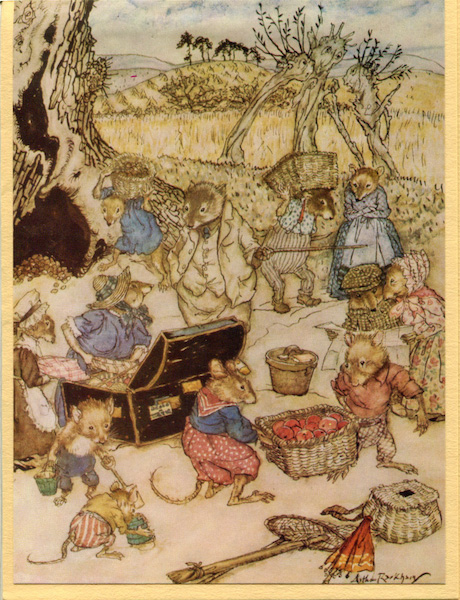
In the early 1980s, there was a resurgence of illustrated folk and fairy tales that echoed the turn-of-the-century tide of gift books for children, featuring such Golden Age illustrators as Arthur Rackham, W. Heath Robinson, Kay Nielsen, and Jessie Willcox Smith. As a child who grew up in the 50s and 60s, I’d missed this early wave of enchanting books until many of those illustrations were being reprinted as greeting cards and posters. By 1987, I was well into children’s literature. That’s when I fell in love with the work of Jessie Willcox Smith. Smith’s portraits of children for Little Women and The Water Babies, among other books, landed her the lucrative job of illustrating every single cover of Good Housekeeping from 1917 through 1933, some 200 paintings. She was the first woman illustrator to earn a million dollars.
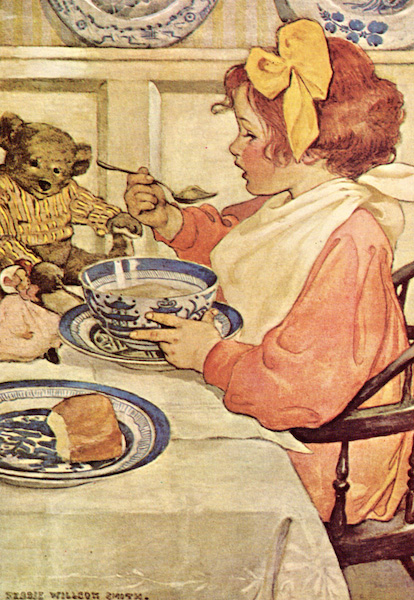
Green Tiger Press brought pre-1940 forgotten children’s illustrations like Smith’s out of the attic and into the form of cards, posters, and books, sold in bookstores and gift shops. I bought a poster of Smith’s illustration of a girl eating porridge with her teddy bear. I hung it in our dining room and decorated the entire room around it, down to the color of the curtains and the Canton Blue dishes. I have the greeting card of that image, hand-tipped, from Green Tiger Press. When my husband and I landed in California, I knew I had to make a stop there.
Green Tiger Press was founded in 1970 by Harold Darling and his wife, Sandra Darling. Before Green Tiger, Harold founded an art-house film club, Unicorn Cinema, and later with his wife, Mithras Books. To get to the tiny, dark, cinderblock theater, you had to walk through their bookstore where you bought your ticket, a mug of tea, and a bag of popcorn. Imagine a bookstore that smelled like popcorn! People saw films by Truffaut and an early effort by George Lucas, who, as described in the theater program, might amount to something as a director.
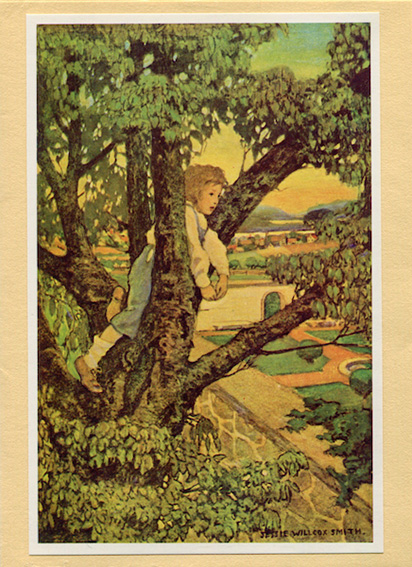
The cinema and the bookstore, businesses slanted away from the establishment, gave hints of what was yet to come from Green Tiger Press. Sandra Darling designed gorgeous round flyers for the theater. She and Harold couldn’t afford to refinish the bookstore’s floor, so they scattered paper ephemera in a collage and lacquered it. Son Benjamin Darling sat on the floor, exploring the images and words, when he wasn’t being “babysat” in the theater, watching films like Yojimbo. Harold wrote the copy for the theater’s membership card:
You have waited too long for your Unicorn Membership card. Those who make the cards for us have hung timeless like dusty mirrors, moving only to brush life away. They only now have awakened, only now have turned and stretched and uncoiled like flowers watched in their growth. They have been out of time like children excused from the ticking school room. Only now does the engine turn, the horses move suddenly to flight, the music hasten into gaiety. Only now does your year begin.
The Unicorn and Mithras both closed in 1982. By then Green Tiger Press had been awakened, its magic horses flying, and images from Harold Darling’s vast collection of vintage ephemera (some 100,000 pieces) dusted off and remade into books, cards, and posters for people like me who had waited too long for products they didn’t realize they needed, but definitely did.
Green Tiger Press in 1987 was housed in a pink stucco building that was formerly a DeSoto car dealership. Inside, a green tiger carousel horse greeted customers. Teddy bears, Raggedy Anns, a rocking horse, and a mannequin with pearl-entwined hair added to the cozy clutter and air of mystery. I loaded up on bookplates, greeting cards, and, among other goodies, a 1972 book called All Mirrors Are Magic Mirrors: Reflections on pictures found in children’s books by Welleran Poltarnees (Harold Darling’s pseudonym — devotee of Lord Dunsany’s fantasy novels).
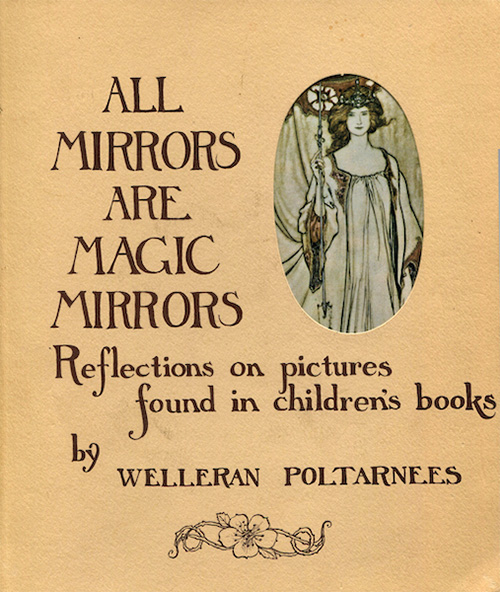
Recently, I rediscovered my copy of Mirrors. To quote the curator of last year’s exhibit of Darling enterprises, “Tigers, Unicorns, & Puppy Dog Tales,” at the La Jolla Historical Society: “the world is not in a pretty place right now … It’s important that we take some steps away from AI and enjoy [things] that have a place in our culture.”
I agree the world needs magic and not the AI kind. Thirty-seven years after I bought Mirrors, I took it to bed with me after a long day of mostly unenjoyable things. The paperbound book’s cover is die-cut to reveal an oval of a Rackham print tipped-in on the title page. On the back cover is this advertisement:
The Green Tiger Press believes that the works of great children’s illustrators are an inadequately explored territory with resources of vast beauty and power, and has dedicated itself to making these treasures more accessible.
Thank heaven, they took the risk. Inside the book, above an Edward Ardizzone sketch, reads: “Life moves so swiftly, is such a blur, that all we need to have the frenzy stilled so that we may inspect the furniture of our world. The child, not long ago a resident of stillness, needs such opportunities and the picture book provides them. Acts of arrest and selection are acts tending toward understanding and tranquility.”
The presentation of the book itself is tranquil. Printed on textured ecru paper in sepia ink, Mirrors is divided into seemingly random chapters such as, “The importance of stylistic & temperamental affinity between author and illustrator,” and “Picturing the realm of faerie.” Nothing in this book is random. Carefully curated images are hand-tipped, ranging from Rackham to Sendak. Sendak’s In the Night Kitchen is described as “a dream of contentment, of warmth and familiarity and ease. It is a dream in which the dreamer joyfully controls the world he has created, in which he simply revels in the wonderful everydayness of everyday things, taking flight among them out of exuberance and the pleasure in the sensation of being.”
This tender description propelled me back to a class on the modern picture book I once taught at Hollins University. Because I’ve always felt like a fraud as a teacher, I set aside my true feelings about picture books and relied on critics who made important observations such as, “picture storybooks provide language input for children … because of the vocabulary and the syntax they include, picture books provide models that can influence a child’s language.” I should have relied upon the “vast beauty and power” of books produced by the very caring Green Tiger Press. I will, if I ever get the chance again.
And because there are more Green Tiger Press books to explore, I’ll continue the Green Tiger story in Part Two.
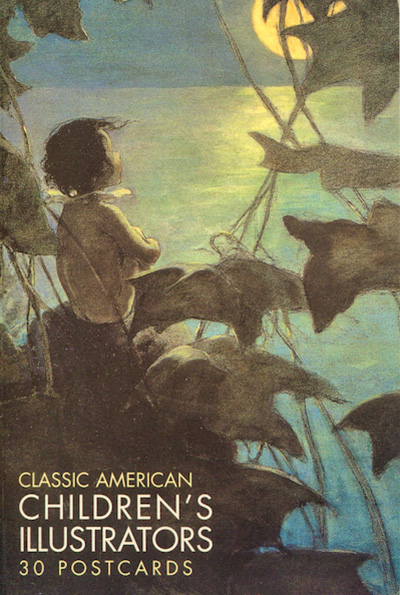
and thought that she looked at him,”
one of 16 paintings for The Water Babies, 1916

Thanks for posting this. Harold Darling was my uncle and I had no idea he and my aunt did this.
Hi, Craig: Your aunt and uncle left behind a valuable legacy. I treasure all my Green Tiger Press books, greeting cards, and I even bought a 1974 calendar from Etsy. As an illustrator friend of mine put it, they were retro before anyone else was – true visionaries. Thanks for stopping by.
I bought some cards from The Green Tiger Press at the Branywine River Museum for $1.00 each about 40 years ago. How I wish I had bought a few hundred cards, I could use them now as birthday cards for my 21 great grand children ! As it is I treasure the cards so much that it is hard to part with them .
I did enjoy this article and thank you for writing it !
Margrete Glaser